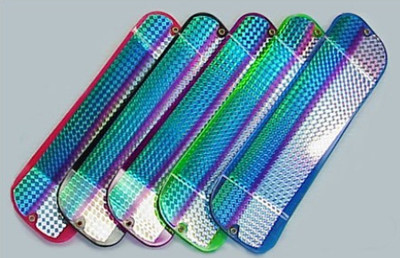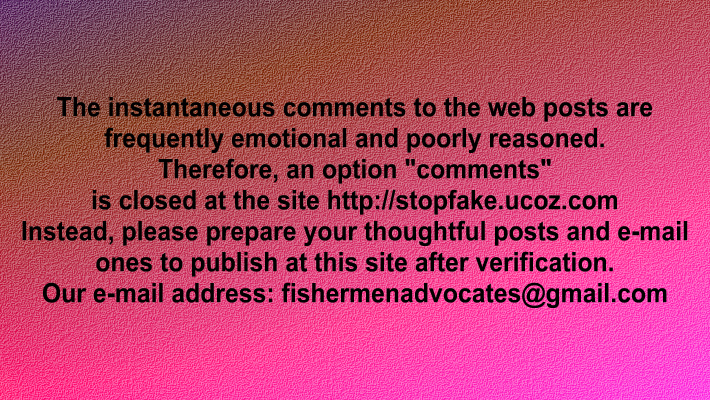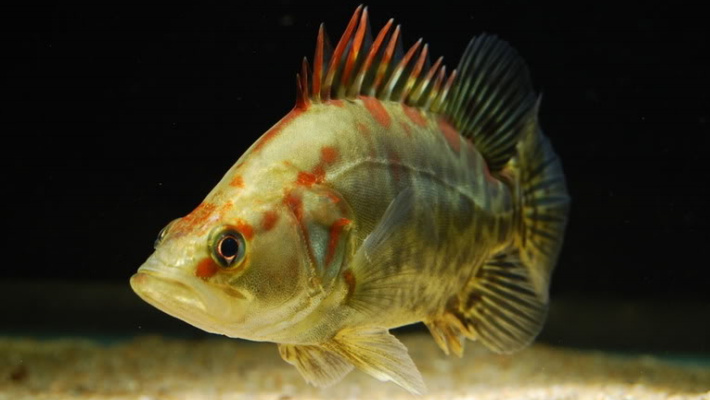Animal responses to holographic patterns
In ethological literature, little is known about responses of fish and other animals to holographic foils which may be used in decoration of nests, sexual and schoolmate dummies, artificial fishing lures and other objects.
To our knowledge, Östlund-Nilsson & Holmlund (2003) offered colored metal foil sticks (15 mm length) to males of three-spined stickleback, Gasterosteus aculeatus, to decorate their nests and found that males preferred sticks of red color. Even earlier, Darkov (1980) studied schooling behaviour of sunbleak, Leucaspius delineatus, and found that fish preferred to school with the silvery models than with the black models.
However, in both these works the influence of holographic patterns on the behavioural responses of fish has not been studied.
Experimental procedure
Our experiments were carried out in an aquarium of 30 x 30 x 60 cm sizes under the daylight illumination. The aquarium bottom was covered with the pebbles of medium size (10-15 mm). At the distance of 3 cm from the side wall the lifting transparent glass was located. This glass was used to stick holographic models (see below). At the distance of 10 cm from this glass the frosted lifting glass was located. When animals moved near this glass, this glass was lifted and animals could see models.
This tank was used as aquarium to study fish and as terrarium to study lizards.
The experimental fish were wild perch, Perca fluviatilis (5-7 cm total length), wild roach, Rutilus rutilus (5-7 cm total length), and wild sunbleak, L. delineatus (about 4 cm total length). Fish were fed live bloodworms. The experimental lizards were sand lizards, Lacerta agilis (6-8 cm total length), which were fed live room flies and small grasshoppers (without one wing or one hind leg).
When animals discovered models, they usually moved towards these models. Three types of responses were fixated: 1) the first movement to the left or right model, 2) staying near the left or right model during 30 min, and 3) the first attempt to bite the left or right model. As animals observed both models at the same time for free choice, the method of paired comparisons (sign test) was used for statistics.
To make models, holographic foils produced by WTP Inc., USA (http://www.wtp-inc.com/color-card) were used.
Small holograpic fields
Fish
The sizes of models were 20 x 5 mm. Two models were placed horizontally at the distance of 10 cm from each other, at the height of 5 cm from the bottom and at the distance about 12-14 cm from the fish.
In the experiments of this type with perch and roach, the left model made of red plain foil, WTP 45, and the right model made of red holographic foil with large horizontal streaks, WTP 825, were compared. In all experiments with permutation models from left to right and vice versa, perch and roach preferred to approach, stay and bite without hesitations the holographic model over the plain model (sign test, P < 0,01).
However, fish were no able to discriminate models with the similar holographic patterns like red prism glitter, WTP 355, and red mini scale, WTP 185.
In general, fish can be trained to discriminate visual abstract patterns (for review, see Northmore et al., 1978), illusory patterns (Wyzisk & Neumeyer; 2007; Sovrano & Bisazza, 2009; Agrillo et al., 2013), mirror patterns (Gierszewski et al., 2013) and naturalistic forms (Schluessel et al., 2012). However, in our experiments wild perch and roach were untrained for the aims of visual discriminations and generalized similar holograpic patterns.
Lizards
Because lizards are more sensitive to the light of shorter wavelengths, models of blue color were used. Models made of blue plain foil, WTP 43, and blue holographic foil with large horizontal streaks, WTP 823, were compared. In all cases, lizards preferred the holographic model over the plain model (sign test, P < 0,01).
However, lizards were no able to discriminate models with the similar holographic patterns like blue prism glitter, WTP 353, and blue mini scale, WTP 183.
Basic wooden decoys
In this part of the experiments, we considered how predatory fish responded in the field to the plain foils and holographic foils with the different patterns.
Basic wooden decoys are lathed practically of any timber, including an imported balsa, and have not any concavities. Commonly, lures have an usable cylindric shape (with the flat or roundish ends), an elongated oval shape, an elongated barrel-like shape (with the flat ends) and an elongated drop-like shape (with the most diameter in the tail, near to the hook). Decoys do not equipped with self-righting ventral hooks, so their rostrums have not skews for sinking or lifting.
To use 2D & 3D artificial eyes, recesses with the flat bottom are milled in the decoy bodies.
Each decoy has the central longitudinal hole and is strung directly on the fishing line, resting on the treble hook. To fish pike, Esox lucius, with sharp teeth, steel leaders are used. The treble hook is decorated with the woolen or synthetic material, commonly of white or light grey colors.
In our experiments, waterproof cylindric wooden decoys of 5.0 cm length and 1.0 cm diameter were used. Their bodies were enveloped with silvery plain foils and sivery holographic foils described below. In addition, 2D eyes 7/32” with the red iris, WTP 405, were sticked bilaterally in the head part of all decoys.
Compared decoys were tested in pairs using standard trolling technique on the two sides of the boat at the same time. Trolling was carried out in daytime at the depth 2.5-3.0 m. The distance between moving decoys was about 2 m. Visibility in the water was 0.6-0.8 m for Secchi disk. Thus fish could not see both compared lures simultaneously and therefore independent samples were used for statistics.
The most abundant predatory fish like perch, P. fluviatilis, pikes, E. lucius, zanders, Stizostedion lucioperca, and asps, Aspius aspius, were catched and considered in the general pool.
In an aquarium when two flat foil stripes (20 x 5 mm) are static, perch have enough time to study both models and prefer (sign test, P < 0,01) the silvery holographic foil with prism glitter, WTP 351, over the silvery plain foil, WTP 41.
In the field, however, perch and other predatory fish are forced to attack potential prey very quickly (during split second) and thus they have not enough time to study their visual features. So approximately the same number of perch, pike, zander and asp (Table 1) were caught on decoys enveloped with the plain and holographic foils or with the different holographic foils.
In general (see Curio, 1976), the process of prey-recognition (seconds, minutes, hours) and the process of prey-attack (split second) are the different processes that are separated in time.
|
Species
|
Caught fish number
|
Stimulus #1
(silvery)
|
Stimulus #2
(silvery)
|
Statistics
(n fish per 1 hour of trolling, Student’s t-test)
|
|
perch, pike, zander, asp
|
32
|
prism glitter,
WTP 351
|
without glitter,
WTP 41
|
indifferently
|
|
perch, pike, zander, asp
|
21
|
horizontal lines,
WTP 341
|
vertical lines,
WTP 341
|
indifferently
|
|
perch, pike, zander, asp
|
27
|
stripes tilted to the left,
WTP 201
|
stripes tilted to the right,
WTP 201
|
indifferently
|
Table 1. The results of predatory fish catching in the field on decoys decorated with the plain and holographic foils.
Dodgers and flashers
Oscillating dodgers and rotating flashers are special trolling devices. They have large sizes (up to 30 cm) and are frequently equiped with the holographic foils (Fig 1).

Fig. 1. Trolling flashers with the holographic foils.
Trolling gears with dodgers allow to catch predatory fish of larger sizes than gears without dodgers (Dooley, 1989). It means that strongly vibrating and shining dodgers and flahers repel relatively small predatory fish.
Nothing is known about the effect of holographic patterns.
Medium holographic fields
In the experiments of this type, rectangular models, 4 x 1 cm, and sunbleak (about 4 cm length) had approximately equal sizes to study schooling responses of fish. Three randomly placed horizontal models made of silvery plain foil, WTP 41, and three randomly placed horizontal models made of silvery holographic foils with prism glitter, WTP 351, were compared. In all cases, highly schooling sunbleak (1, 2 and 3 individuals) preferred to approach and to stay near the holographic models over the plain models (sign test, P < 0,01).
However, sunbleak were no able to discriminate models with the similar holographic patterns like silvery prism glitter, WTP 351, and silvery mini scale, WTP 181.
Large holographic fields
In these cases, the sizes of holographic objects are much more than the sizes of the experimental animals. The rectangular photos (20 x 10 cm) of underwater plants and rectangular photos of grass at the level of sand on the one hand, and the holographic panels (20 x 10 cm) of the various types on the second hand were used to study the responses of fish and lizards, respectively.
Fish and lizards were introduced individually in aquarium or terrarium in the center between photos and holographic panels and released. In all cases, fish and lizards moved immediately or after short confusion towards the natural backgrounds avoiding thus the large holographic panels (sign test, P < 0,01).
All holographic patterns scare. In other words, fish and lizards are not able to distinguish scared holographic patterns.
These results are not new. It is known, for example, that holographic foils are repellents for birds and produced on an industrial scale (see https://www.shopwtp-inc.com/index.php?cPath=34).
Basic references
Agrillo C., Petrazzini M.E.M., Dadda M. 2013. Illusory patterns are fishy for fish, too. Frontiers in Neural Circuits 7, doi: 10.3389/fncir.2013.00137
Curio E. 1976. Ethology of predation. Zoophysiology and Ecology 7. Berlin, Springer
Darkov A.A. 1980. Ecological features of visual signalling in fishes. Moscow, Science Publishing
Dooley R.H.A. 1989. The response of rainbow trout (Salmo gairdneri) to lures with special reference to color preference. Master’s Thesis. University of British Columbia, Canada, 1-76
Gierszewski S., Bleckmann H., Schluessel V. 2013. Cognitive abilities in malawi cichlids (Pseudotropheus sp.): matching-to-sample and image/mirror-image discriminations. PLoS ONE 8: e57363. doi:10.1371/journal.pone.0057363
Northmore D., Volkmann F.C., Yager D. 1978. Vision in fishes: color and pattern. The Behavior of Fish and Other Aquatic Animals. Edited by D.I. Mostofsky. Academic Press, New York
Östlund-Nilsson S., Holmlund M. 2003. The artistic three-spined stickleback (Gasterosteus aculeatus). Behavioral Ecology and Sociobiology 53, 214-220
Schluessel V., Fricke G., Bleckmann H. 2012. Visual discrimination and object categorization in the cichlid Pseudotropheus sp. Animal Cognition 15:525-537
Siebeck U.E., Litherland L., Wallis G.M. 2009. Shape learning and discrimination in reef fish. Journal of Experimental Biology 212, 2113-2119
Sovrano V.A., Bisazza A. 2009. Perception of subjective contours in fish. Perception 38, 579-590
Wyzisk K., Neumeyer C. 2007. Perception of illusory surfaces and contours in goldfish. Visual neuroscience 24, 291-298
| 







 SUBSCRIBE
SUBSCRIBE



